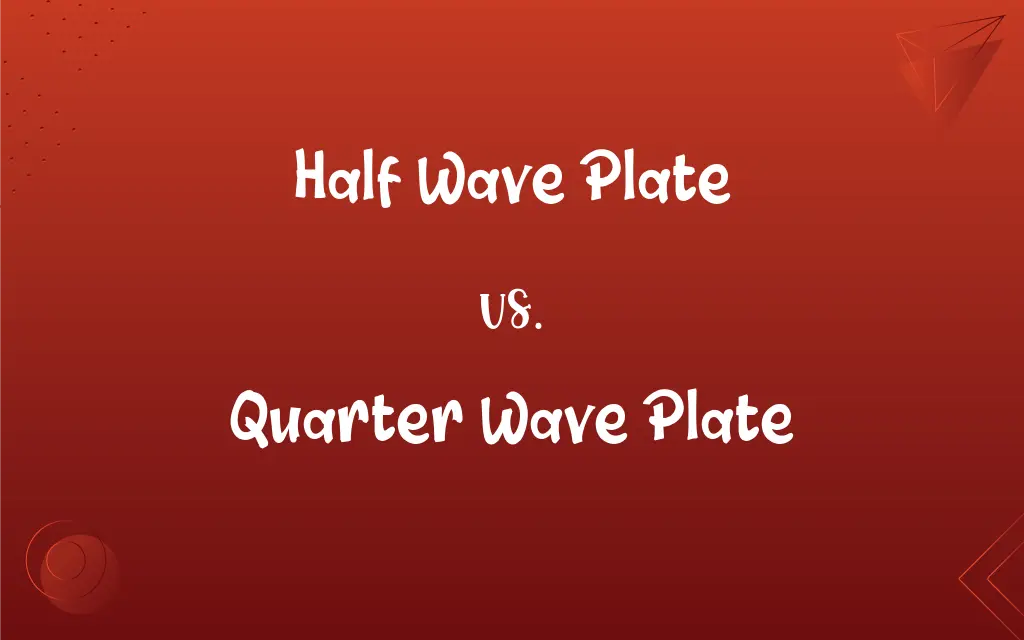Half Wave Plate vs. Quarter Wave Plate: What's the Difference?
Edited by Aimie Carlson || By Janet White || Published on December 2, 2024
A half-wave plate shifts the polarization of light by 180°, while a quarter-wave plate converts linear polarization to circular polarization or vice versa.

Key Differences
A half-wave plate is an optical device that alters the polarization state of light passing through it by half a wavelength, effectively rotating the polarization direction of linearly polarized light. It works by introducing a phase shift between the orthogonal components of the electric field of the light wave, resulting in a polarization direction rotation. Quarter-wave plates, in contrast, are designed to introduce a quarter-wavelength (λ/4) phase shift between the orthogonal polarization components of the light. This phase shift is crucial for converting linearly polarized light into circularly polarized light and vice versa.
The half-wave plate is used for polarization rotation, the quarter-wave plate serves a different purpose in manipulating the state of polarization from linear to circular or elliptical. This ability makes quarter-wave plates essential in applications requiring circular polarization, such as in optical communication, microscopy, and laser systems where control over the polarization state is crucial.
The key distinction lies in the phase shift each plate introduces and the resultant effect on the polarization of light. The half-wave plate's 180° phase shift is perfect for applications needing a specific linear polarization orientation, while the quarter-wave plate's 90° shift is ideal for applications that require changing linear polarization to circular polarization.
Both devices showcase the importance of controlling light's polarization in various scientific and technological fields. The choice between a half-wave and quarter-wave plate depends on the desired outcome in the polarization state of light, demonstrating the versatility and essential role of polarization control in optics.
Comparison Chart
Phase Shift
180° (half a wavelength)
90° (quarter of a wavelength)
ADVERTISEMENT
Polarization Conversion
Rotates the polarization of linearly polarized light
Converts linear polarization to circular polarization and vice versa
Primary Use
Polarization direction adjustment
Polarization state change (linear to circular or elliptical)
Operation Principle
Introduces a phase shift between orthogonal components by half a wavelength
Introduces a phase shift between orthogonal components by a quarter wavelength
Applications
Optical engineering, polarization control
Optical communication, microscopy, laser systems
Half Wave Plate and Quarter Wave Plate Definitions
Half Wave Plate
Manipulates linear polarization.
A half-wave plate was crucial in our experiment for manipulating the linear polarization.
ADVERTISEMENT
Quarter Wave Plate
Manipulates the polarization state.
We utilized a quarter-wave plate to manipulate the laser light's polarization state effectively.
Half Wave Plate
Optical device that rotates the polarization of light.
The half-wave plate was adjusted to align the laser's polarization with the optical system.
Quarter Wave Plate
Essential for circular polarization applications.
In the laser system, the quarter-wave plate enabled the use of circular polarization.
Half Wave Plate
Alters the phase of light components.
The experiment's success depended on how the half-wave plate altered the light's phase components.
Quarter Wave Plate
Converts linear to circular polarization.
A quarter-wave plate was used to generate circularly polarized light for the optical setup.
Half Wave Plate
Used for polarization direction control.
The half-wave plate precisely controlled the polarization direction of the transmitted light.
Quarter Wave Plate
Introduces a 90° phase shift.
The quarter-wave plate's 90° phase shift was key to changing the light's polarization state.
Half Wave Plate
Introduces a 180° phase shift.
Using a half-wave plate, we achieved the required polarization orientation.
Quarter Wave Plate
Alters orthogonal light components differently.
The quarter-wave plate altered the orthogonal components of light to achieve elliptical polarization.
FAQs
Are half-wave plates adjustable?
Yes, adjusting their orientation changes the angle of rotated polarization.
How does a quarter-wave plate work?
By introducing a quarter-wavelength phase shift to convert linear polarization to circular.
Can a half-wave plate create circular polarization?
No, it rotates linear polarization but does not convert it to circular.
What materials are used to make quarter-wave plates?
Common materials include quartz, mica, and other birefringent crystals.
What applications utilize half-wave plates?
They are used in optical engineering, lasers, and polarization control devices.
What limitations do half-wave plates have?
They cannot change linear polarization to circular or vice versa.
What is the principle behind a quarter-wave plate?
It operates on birefringence to introduce a 90° phase shift between orthogonal polarization components.
Can a quarter-wave plate work with any light source?
It works best with coherent light sources like lasers.
What is a half-wave plate used for?
To rotate the polarization direction of linearly polarized light.
Why are quarter-wave plates important in optical communication?
They enable the use of circular polarization, reducing interference and improving signal quality.
How do you determine the orientation of a quarter-wave plate?
By aligning its fast and slow axes with the polarization direction of the incident light.
How precise must the alignment of a half-wave plate be?
Very precise; small misalignments can significantly affect the polarization rotation.
Can half-wave plates be used in imaging systems?
Yes, for controlling the polarization state of light to enhance image contrast.
How do quarter-wave plates affect light intensity?
They do not significantly affect intensity but alter the polarization state of the light.
What happens if a half-wave plate is misaligned?
The polarization direction of the light may not be correctly rotated.
What is the effect of wavelength on quarter-wave plate functionality?
They are wavelength-specific; effectiveness varies with the wavelength of the light.
Is it possible to use multiple half-wave plates in series?
Yes, for complex polarization control, but alignment is crucial.
How does temperature affect quarter-wave plates?
Temperature changes can alter the birefringence properties, affecting performance.
Can quarter-wave plates be used to manipulate elliptical polarization?
Yes, they can convert elliptical to linear polarization or vice versa.
What is a zero-order wave plate?
A wave plate designed to function effectively at a specific wavelength, minimizing chromatic dispersion.
About Author
Written by
Janet WhiteJanet White has been an esteemed writer and blogger for Difference Wiki. Holding a Master's degree in Science and Medical Journalism from the prestigious Boston University, she has consistently demonstrated her expertise and passion for her field. When she's not immersed in her work, Janet relishes her time exercising, delving into a good book, and cherishing moments with friends and family.
Edited by
Aimie CarlsonAimie Carlson, holding a master's degree in English literature, is a fervent English language enthusiast. She lends her writing talents to Difference Wiki, a prominent website that specializes in comparisons, offering readers insightful analyses that both captivate and inform.







































































